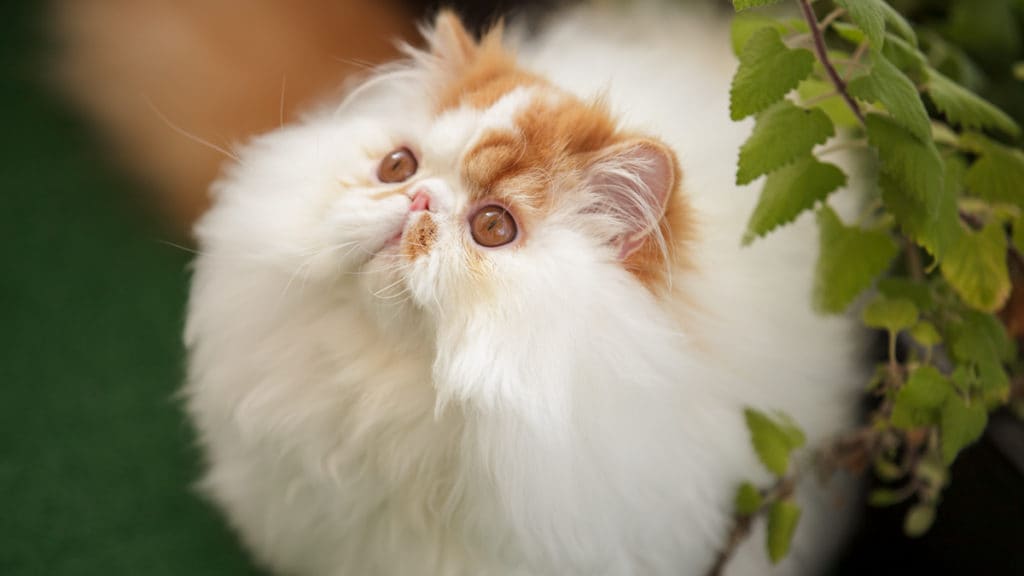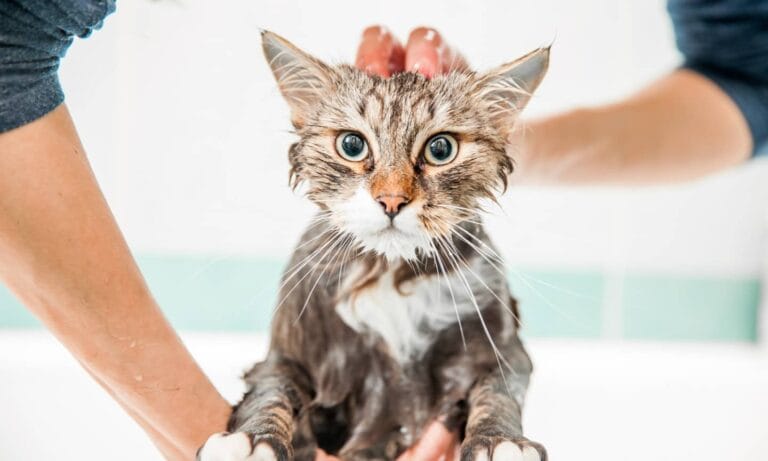Hair, hair—everywhere! Sound familiar? You probably have long-haired cats in your house—ones that leave tufts of fur on the comforter, in their favorite spots on the couch, and all over the pair of pants that didn’t make it into the laundry basket (not that we’re calling you out or anything). And we haven’t even talked about the dreaded hairballs that await unsuspecting bare feet. Unless you’re in the market for a hairless cat, you’re going to face this kind of thing on a daily basis. But with a regular pet grooming routine, the hair-raising problems that plague long-haired cats and their owners will soon disappear. We’ve enlisted the help of Sarah (Miller) Thomas, Certified Feline Master Groomer at Wil-O-Paw Animal Hospital in Coloma, Michigan, to give us some expert tips on caring for long-haired cats.
Start Them Young
Brushing is a necessary part of pet grooming, says Thomas, and it’s important to begin the process during the first few months of kittenhood. You can do this in short sessions that include cat treats so that your kitty learns to think of brushing as a positive experience. The same can be done with older long-haired cats. Try the KONG Cat ZoomGroom Multi-Use Brush for a gentle brushing session. But some furry felines seriously hate brushing, and they let you know it. In this case, Thomas recommends leaving the job to a pet grooming professional instead of only brushing them once or twice a year, as their brush hating will only get worse.
Establish a Schedule
Even though they share the trait of a flowing coat, long-haired cats have their own unique grooming needs. “If your cat is being groomed professionally every 4-8 weeks, then very little brushing is required at home. Some still benefit from a weekly 5-10 minute comb-out while on a monthly grooming schedule,” says Thomas. She adds that de-shedding tools are helpful, but cautions pet parents not to overuse them in any one area, which can cause skin irritation. The FURminator Long Hair deShedding Edge and Safari Shed Magic De-Shedding Tool work well to reduce shedding in long-haired cats, which means less hair to ingest.
Prevention Is Key
Have you ever had to deal with matting? According to Thomas, prevention is the best solution. And the way to do that is with professional pet grooming. “Mats are formed when the natural oils in the skin build up while shedding hair is trying to fall out. The shedding hair sticks to the greasiness and begins to form a tangle. If not removed, the tangle quickly grows into a mat or even a pelt!” says Thomas. You might be able to brush out a small mat, but large, tight mats can become painful for kitties, and they need to be shaved off by a groomer.
Can a Lion Cut Tame the Mane?
You’ve probably considered shaving your long-haired cat, especially if you live in a hotter climate. Before you send your furball off to get those long locks shaped into a safari-style lion cut, Thomas warns that it might not be the best option for every aspiring wildcat. “Cats have very thin skin that must be stretched taut to prevent injury while using clippers. For this reason, elderly cats or cats with thin skin due to health conditions may not be the best candidates for shaving,” she explains. But there’s good news for healthy long-haired cats. A lion cut is fine for them if the owner wants to minimize shedding. And for cats that live in hot environments, “regular, full-coat grooming can prevent extra shedding hair from building up and trapping hot air next to the skin.” If you do go for the shave, just be sure to protect your newly shorn mini-lion from sunburn.
Surviving the Dreaded Cat Bath
To bathe or not to bathe—that’s the question for parents of long-haired cats. Washing cats might not seem like your idea of fun on a weekend, but it can help eliminate oil buildup and reduce cat dander, a common allergen. You can do it yourself at home, or take your kitty to a professional that’s experienced at washing cats. Thomas notes that, contrary to popular belief, most cats enjoy the bathing process, but you should keep these things in mind before washing cats:
Mats and drying: A good degreasing shampoo can help prevent mats. Those that haven’t been removed can shrink as they dry, which pulls your pet’s skin. Hand drying, not air drying, should be done to prevent this.
Shampoo choice: Use a cat-safe shampoo that’s specially formulated for washing cats, and be careful around the facial area. FURminator Hairball Prevention Shampoo is a blend of natural ingredients with no parabens or chemical dyes.
Health issues: Cats with heart or thyroid problems might not be able to withstand the entire pet grooming process in one session. Consult your vet and talk to a professional cat groomer.
Frequency: How often your cat needs bathing depends on the breed and coat consistency. It could be anywhere from once a week to every 3 months—it all depends on the cat.
“Treating” the Skin and Coat Right
There are many options for functional treats—from hairball-reducing snacks to those that can help improve coat quality. Hairball treats “usually work by helping existing hairballs pass easily through the digestive tract,” says Thomas, although they can’t prevent your cat from licking themselves and ingesting more hair. She suggests pairing a hairball-reducing diet with regular pet grooming. Greenies Feline SmartBites Hairball Control Chicken Flavor Cat Treats are tasty, dual-textured snacks that help control hairballs and ease digestion. To keep your long-haired cat’s coat full and luxurious, check out Greenies Feline SmartBites Healthy Skin & Fur Salmon Flavor Cat Treats. They deliver a guaranteed level of omega-3 fatty acids from fish oil in a crunchy, savory treat for skin and coat health. As with any treat, these should be given in moderation. “Cat treats with fish oil or omega-3 fatty acids are known to help with coat quality and may be a good option as long as the owner is careful not to overfeed,” notes Thomas. But she also points out that a poor-quality coat could be the sign of kidney or thyroid disease or another health concern, so be sure to discuss your pet’s condition with your veterinarian.
How the Pros Do It
Ever wondered what happens during a pet grooming session? How do they turn a scruffy feline into a proud lion with a radiant coat? Thomas runs us through the steps:
1. It starts with a nail trim and a small, sanitary shave on the rear.
2. The next and most important step is a good degreasing bath with a cat-safe shampoo. Any cat that has not been bathed has not been truly groomed! At least two lathers of shampoo are applied until the hair is squeaky clean.
3. The cat is then wrapped in a towel, and the ears and eye area are carefully cleaned.
4. Next comes the blow-dry with a high-velocity dryer. This dries the coat to the skin, blows out shedding hair and tangles (reducing brushing time afterwards), and allows the groomer to see every inch of skin, many times exposing ticks, lumps, abscesses, and even puncture wounds of which the owner was not aware.
5. Finally, kitties get a thorough combing out to remove any excess shedding hair. A variety of tools are used, including greyhound combs, smaller face and feet combs, rubber curry combs and de-shedding tools.
6. A finishing spray/cologne is applied, and the grooming process is complete!
So, if you want to cut down on furry dust bunnies and inadvertently wearing your cat’s hair as an accessory, take some time to plan out your kitty’s unique pet grooming schedule. Aside from reducing the amount of shedding, it’s a pretty important part of overall health for long-haired cats.

Nikki Naser, BeChewy Senior Editor
Instead of owning 30 cats, Nikki has an impressive collection of 30 cat-themed T-shirts, and just 4 pets—a ginger-haired senior cat, a senior Maine Coon, a middle-aged Choodle, and a young kitty who showed up one day on the back steps. A former Orlando resident, Nikki worked on several tourism publications before moving to South Beach. When she’s not stopping to take pics of community cats to post on Instagram, Nikki spends her time with the office pets at Chewy, writing for their BeChewy blog.
Share:
















